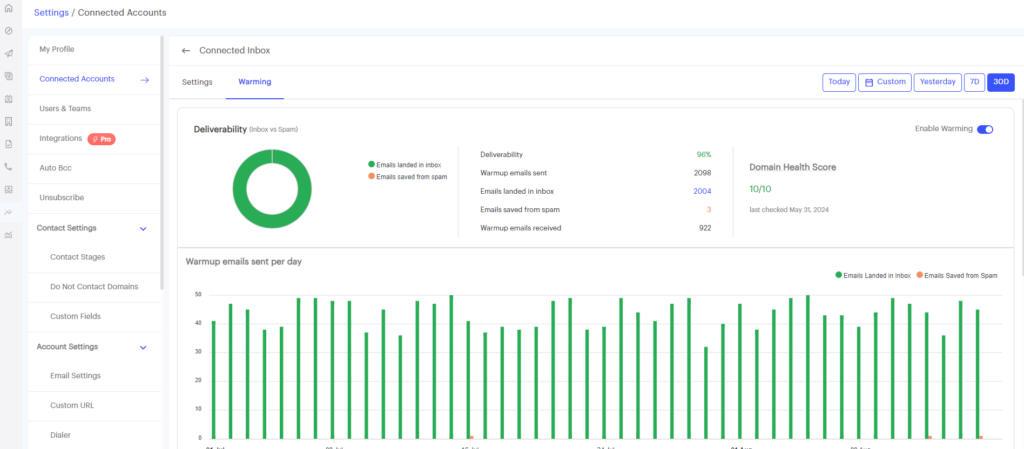
How to Become a Successful SDR: 11 Tips from Experts
Ever feel like you’re spinning your wheels, trying to figure out how to become a successful SDR?
It’s a tough job—balancing cold calls, emails, and prospecting, all while hitting your KPIs. Luckily, there’s plenty of wisdom out there from experienced sales pros who’ve been in your shoes.

We’ve rounded up 11 actionable tips to help you sharpen your skills, close more deals, and make the leap to the next level. Let’s dive in!
11 tips from experienced folks to become a successful SDR
Study successful colleagues
Learn from the best on your team. Spend time reviewing call recordings or shadowing successful colleagues to understand their approach. Notice how they handle objections. Apply their best practices, adapt what works, and make it your own.
Be Coachable. Be Hungry
The best SDRs are those who are always open to feedback and hungry to improve. The ability to be coached is the key to long-term success in sales. Never stop learning from your peers, mentors, and even from your mistakes.
Sell the Meeting, Not the Product
Your primary job as an SDR is to sell time—time to have a conversation, not the product itself. Focus on securing that initial meeting rather than overwhelming your prospect with product details. Build curiosity and focus on solving problems.
Use the right tech stack
To be a successful SDR, you need to spend most of your time prospecting, not buried in admin tasks. Unfortunately, many sales tools are clunky and time-consuming.
Opt for consolidated solutions like Salesgear, which can save you up to 60% of your time by automating irrelevant tasks. This allows you to focus on what truly matters—driving results.

Prioritize Adding Value to Conversations
Focus on delivering value over multiple touches. Start with small talk, follow up with relevant resources or event invites, and let your engagement grow naturally. By the time you ask for a meeting, you’ve built trust and demonstrated value.
Use Permission-Based Cold Calling
Rather than steamrolling into a sales pitch, use a permission-based approach. Acknowledge that it’s a cold call and ask if they have five minutes to discuss how you can help. This polite and respectful approach makes prospects more receptive.
Suggested Read: 30 Best cold call scripts to secure more meetings
Qualify your prospects
It’s a no brainer.
One of the most crucial skills you’ll develop is knowing who to target. It’s tempting to book as many meetings as possible, but not every prospect is worth your time.
Focus on quality over quantity—disqualifying the wrong prospects helps you spend more time with those who are a real fit. Remember, fewer but better conversations lead to higher conversion rates and happier AEs.
Be enthusiastic and direct
Enthusiasm is contagious—when you bring energy to a call, prospects are more likely to stay on the line.
But enthusiasm alone isn’t enough; be direct when asking for the meeting and always confirm a time before ending the call. The balance of excitement and clear communication can dramatically increase your success rate.
High energy and enthusiasm can keep prospects engaged. Always ask for the meeting and confirm a time before hanging up.
Track Your Metrics and Optimize
Understanding your sales funnel is crucial. Track how many calls lead to conversations, how many conversations convert into meetings, and how many meetings turn into deals. These insights will help you optimize your efforts and meet your goals more efficiently.
Resource: 25 B2B Sales Metrics that teams should track week over week
Focus on the Right Goals
It’s not always about the immediate win. Your goal should be to build awareness and establish human connections. These often lead to more meaningful interactions down the line, even if you don’t book a meeting on the first try.
Understand Your Prospect’s Problems
Instead of focusing solely on your product, shift your attention to the challenges your prospects face.
Deeply understanding their pain points allows you to frame your solution in a way that resonates with them.
The better you know their problems, the more relevant your outreach will feel. And when you can offer real value, prospects will be more willing to engage.
Leverage small talk (and personal connections)
Don’t underestimate the power of small talk. Starting with a friendly conversation before diving into your pitch can build rapport and make the prospect feel more comfortable.
This is especially important when selling to C-level executives, who appreciate a more personal touch.
Small talk may seem trivial, but it can be the difference between getting a meeting or getting ignored.
Disqualify leads when necessary
It’s not just about booking meetings—it’s about booking the right ones.
If a prospect doesn’t have the right budget, authority, or need, don’t be afraid to disqualify them. Your time is valuable, and spending it on unqualified leads can hurt your pipeline.
Disqualifying saves time and increases the quality of meetings you pass to your AE.
Key Takeaways
Becoming a successful SDR isn’t about one magic formula—it’s about continuously learning, qualifying the right prospects, and using the right tools to make your job easier.
Apply these tips, stay open to feedback, and most importantly, be persistent. With the right mindset and approach, you’ll be on your way to smashing your sales goals.
[This post first appeared on Outbound Simplified newsletter]